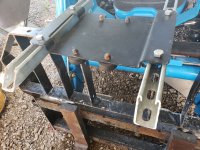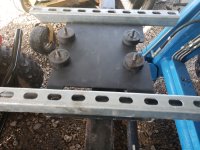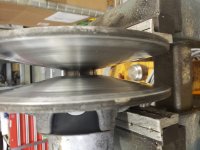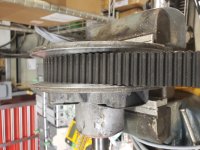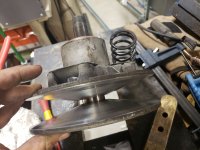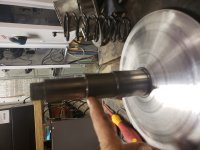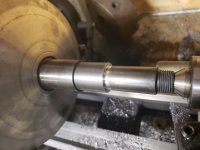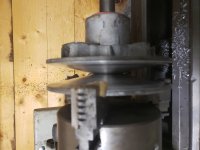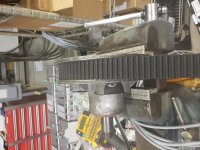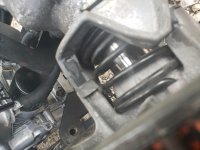strantor
Platinum Member
I have purchased a used American Sportworks Bulldog 300 UTV and promptly swapped out the 277cc Kohler engine for a Predator 670cc engine. The previous owner had the engine scooted back pretty far and the belt was very loose, appearing as an oval when the engine was off (this will come in later).
Before doing the swap I researched the other driveline components to ensure they would handle the 250% increase in power. American Sportworks seems to have standardized on a single driveline setup for nearly all their UTVs, so this little "golf cart"-ish putt-putt has the same CVTech series 06 CVT and Dana 265 transaxle as their 700cc LandMaster. Further research indicates that this CVT is used in performance applications up to 60hp and 6500RPM. I say all that to ensure you that I am nowhere near exceeding the capabilities of this CVT.
Now the issue, with the old engine it was slow. 17mph max. With the new engine, slightly faster (maybe), haven't clocked it, but still slow. While I drive it down the road, I look back at the CVT and see that the rear pulley is not opening up all the way. You can see in the pictures below just how far it opens up by the surface rust on the shaft and the rubber rub marks on the inclines.
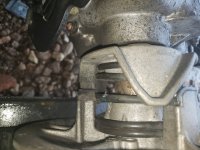
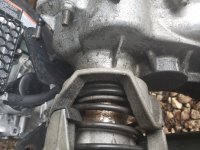
Also, I think maybe the drive pulley is not closing all the way. I don't know exactly how high the belt is supposed to ride on the drive pulley at the highest ratio but I suspect it's all the way at the outer edge, and the polished surface of where the belt rides does not extend that far.
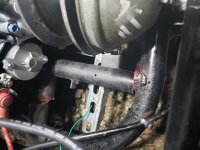
I'm not confident that I fully grasp how a CVT works, so I can't really make a strong educated guess as to the problem. I want to know how to fix my problem but I also have a strong desire to fully understand the workings of this device. Please pardon the following potentially offputting social experiment, but I find that asking questions online generally garners fewer responses than making false statements, so I'm going to act like I know exactly how a CVT works and explain it down to all of you as if you are lowly pupils, and wait for the corrections to come in.
strantor's immutable laws of CVT physics:
1. The drive pulley responds to variations in engine speed.
2. The driven pulley responds to variations in load torque.
3. The driven pulley works against the drive pulley.
4. The drive pulley (assume no belt is on it) will start to close at a given RPM as the weights inside are slung outward by centrifugal force, and the weights push the sliding half of the pulley against the spring. With sufficient RPM the force of the weights is enough to overcome the spring and start to close the pulley. With incremental RPM increases thereafter, the pulley closes with corresponding increments.
5. The driven pulley (assume no downstream load, ex: rear end jacked up, tires spinning freely in air) will be forced open by the belt. As the drive pulley is forced closed by increase in speed, and the belt is drawn toward the drive pulley, it is drawn away from (down into) the driven pulley, forcing it against its spring, open.
6. With a belt on the drive pulley, the belt introduces additional resistance to pulley closure (assisting the spring). Depending on belt tension, that resistance may be enough to slow, stop, or even reverse closure of the drive pulley.
7. Assuming the rear end is jacked up, tires spinning freely, engine at max RPM, drive pulley fully closed and driven pulley fully open (highest achievable ratio)... as load is incrementally applied to the wheels, the load will work against the spring in the driven pulley, forcing the driven pulley closed, leading to an increase in belt tension, forcing the drive pulley open, leading to an automatic reduction in ratio, while engine speed remains constant.
8. There are a number of other factors that influence the above:
A. Static/starting belt tension. If the belt is too slack at rest (center point of drive pulley too close to center point of driven pulley) then there will not be enough belt "meat" to fully open the driven pulley when the drive pulley is fully closed.
B. Belt width. If the belt is not wide enough then there will not be enough belt "meat" to fully open the driven pulley when the drive pulley is fully closed.
C. Free operation of both pulleys. If there is dirt or corrosion which inhibits the free travel of the sliding halves of the pulleys, then, well, they won't fully slide, and you won't get the full range of operation out of the CVT.
D. Weight of sliding weights in the drive pulley. Too light of weights will result in the closing action of the drive pulley being too weak, and unable to close to the appropriate gap for a given load. Conversely, too much weight will result in premature engagement of the belt.
E. Spring force of drive pulley. Too much spring force will be the same effect as too light of weights, and vise versa.
F. Spring force of the driven pulley. Too high of spring force will result in too much tension for a given load, and the same effect as 8.C.
Given the above is absolutely true because I said so, there are only two likely reasons why my CVT isn't working properly:
1. [8.B.] My belt is worn and no longer the proper width.
2. [8.C.] The surface rust and dirt in/on/around my driven pulley is inhibiting full range of motion. Previously under-powered engine and too much belt slack [8.A.] caused by improper engine position adjustment by previous owner, resulted in a portion of the driven pulley's range of motion being unused and therefore free to rust & collect dirt. That portion remains unused (unable to be used) now, until it is taken apart, cleaned, and polished.
Corrective actions 100% guaranteed to solve the problem: replace the belt and tear down/clean the driven pulley.
I have a new belt on order and plan to tear down the pulley later and clean it.
This will work. Change my mind.
(Am I barking up the right tree?)
Before doing the swap I researched the other driveline components to ensure they would handle the 250% increase in power. American Sportworks seems to have standardized on a single driveline setup for nearly all their UTVs, so this little "golf cart"-ish putt-putt has the same CVTech series 06 CVT and Dana 265 transaxle as their 700cc LandMaster. Further research indicates that this CVT is used in performance applications up to 60hp and 6500RPM. I say all that to ensure you that I am nowhere near exceeding the capabilities of this CVT.
Now the issue, with the old engine it was slow. 17mph max. With the new engine, slightly faster (maybe), haven't clocked it, but still slow. While I drive it down the road, I look back at the CVT and see that the rear pulley is not opening up all the way. You can see in the pictures below just how far it opens up by the surface rust on the shaft and the rubber rub marks on the inclines.


Also, I think maybe the drive pulley is not closing all the way. I don't know exactly how high the belt is supposed to ride on the drive pulley at the highest ratio but I suspect it's all the way at the outer edge, and the polished surface of where the belt rides does not extend that far.

I'm not confident that I fully grasp how a CVT works, so I can't really make a strong educated guess as to the problem. I want to know how to fix my problem but I also have a strong desire to fully understand the workings of this device. Please pardon the following potentially offputting social experiment, but I find that asking questions online generally garners fewer responses than making false statements, so I'm going to act like I know exactly how a CVT works and explain it down to all of you as if you are lowly pupils, and wait for the corrections to come in.
strantor's immutable laws of CVT physics:
1. The drive pulley responds to variations in engine speed.
2. The driven pulley responds to variations in load torque.
3. The driven pulley works against the drive pulley.
4. The drive pulley (assume no belt is on it) will start to close at a given RPM as the weights inside are slung outward by centrifugal force, and the weights push the sliding half of the pulley against the spring. With sufficient RPM the force of the weights is enough to overcome the spring and start to close the pulley. With incremental RPM increases thereafter, the pulley closes with corresponding increments.
5. The driven pulley (assume no downstream load, ex: rear end jacked up, tires spinning freely in air) will be forced open by the belt. As the drive pulley is forced closed by increase in speed, and the belt is drawn toward the drive pulley, it is drawn away from (down into) the driven pulley, forcing it against its spring, open.
6. With a belt on the drive pulley, the belt introduces additional resistance to pulley closure (assisting the spring). Depending on belt tension, that resistance may be enough to slow, stop, or even reverse closure of the drive pulley.
7. Assuming the rear end is jacked up, tires spinning freely, engine at max RPM, drive pulley fully closed and driven pulley fully open (highest achievable ratio)... as load is incrementally applied to the wheels, the load will work against the spring in the driven pulley, forcing the driven pulley closed, leading to an increase in belt tension, forcing the drive pulley open, leading to an automatic reduction in ratio, while engine speed remains constant.
8. There are a number of other factors that influence the above:
A. Static/starting belt tension. If the belt is too slack at rest (center point of drive pulley too close to center point of driven pulley) then there will not be enough belt "meat" to fully open the driven pulley when the drive pulley is fully closed.
B. Belt width. If the belt is not wide enough then there will not be enough belt "meat" to fully open the driven pulley when the drive pulley is fully closed.
C. Free operation of both pulleys. If there is dirt or corrosion which inhibits the free travel of the sliding halves of the pulleys, then, well, they won't fully slide, and you won't get the full range of operation out of the CVT.
D. Weight of sliding weights in the drive pulley. Too light of weights will result in the closing action of the drive pulley being too weak, and unable to close to the appropriate gap for a given load. Conversely, too much weight will result in premature engagement of the belt.
E. Spring force of drive pulley. Too much spring force will be the same effect as too light of weights, and vise versa.
F. Spring force of the driven pulley. Too high of spring force will result in too much tension for a given load, and the same effect as 8.C.
Given the above is absolutely true because I said so, there are only two likely reasons why my CVT isn't working properly:
1. [8.B.] My belt is worn and no longer the proper width.
2. [8.C.] The surface rust and dirt in/on/around my driven pulley is inhibiting full range of motion. Previously under-powered engine and too much belt slack [8.A.] caused by improper engine position adjustment by previous owner, resulted in a portion of the driven pulley's range of motion being unused and therefore free to rust & collect dirt. That portion remains unused (unable to be used) now, until it is taken apart, cleaned, and polished.
Corrective actions 100% guaranteed to solve the problem: replace the belt and tear down/clean the driven pulley.
I have a new belt on order and plan to tear down the pulley later and clean it.
This will work. Change my mind.
(Am I barking up the right tree?)
